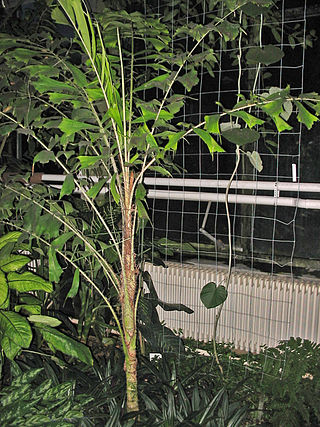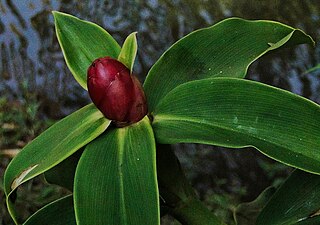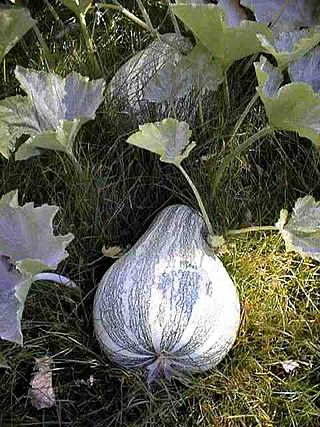
Ficus microcarpa, also known as Chinese banyan, Malayan banyan, Indian laurel, curtain fig, or gajumaru (ガジュマル), is a tree in the fig family Moraceae. It is native in a range from China through tropical Asia and the Caroline Islands to Australia. It is widely planted as a shade tree.
Costus barbatus is a critically endangered species of plant native to Costa Rica.

Costaceae, known as the Costus family or spiral gingers, is a family of pantropical monocots. It belongs to the order Zingiberales, which contains horticulturally and economically important plants such as the banana (Musaceae), bird-of-paradise (Strelitziaceae), and edible ginger (Zingiberaceae). The seven genera in Costaceae together contain about 143 known species. They are native to tropical climates of Asia, Africa, Central America, and South America. Several species are frequently found in cultivation.

Aiphanes is a genus of spiny palms which is native to tropical regions of South and Central America and the Caribbean. There are about 26 species in the genus, ranging in size from understorey shrubs with subterranean stems to subcanopy trees as tall as 20 metres (66 ft). Most have pinnately compound leaves ; one species has entire leaves. Stems, leaves and sometimes even the fruit are covered with spines. Plants flower repeatedly over the course of their lifespan and have separate male and female flowers, although these are borne together on the same inflorescence. Although records of pollinators are limited, most species appear to be pollinated by insects. The fruit are eaten by several birds and mammals, including at least two species of amazon parrots.

Costus is a genus of herbaceous perennial plants in the family Costaceae, erected by Linnaeus in 1753. It is widespread through tropical and subtropical regions of Asia, Africa, and the Americas.

Costus chartaceus, commonly known as the Christmas costus, is a perennial plant with a red inflorescence first described by Paul Maas in 1972. It is native to Colombia and Ecuador but cultivated as an ornamental in other regions. It is not winter hardy.

Costus osae is a species of flowering plant in the family Costaceae. One of many rare tropical plants in the Costus family, Costus osae is a species native to Costa Rica described in 1997 by Paul Maas and Hiltje Maas-van de Kamer. It has also been reported from Colombia.

Cucurbita argyrosperma, also called the cushaw squash and silver-seed gourd, is a species of winter squash originally from the south of Mexico. This annual herbaceous plant is cultivated in the Americas for its nutritional value: its flowers, shoots, and fruits are all harvested, but it is cultivated most of all for its seeds, which are used for sauces. It was formerly known as Cucurbita mixta.

Costus spicatus, also known as spiked spiralflag ginger or Indian head ginger, is a species of herbaceous plant in the Costaceae family.
Costus curvibracteatus is a tropical rhizomatous perennial native to Costa Rica and Panama.

Costus malortieanus, known as Stepladder Plant, Spiral Ginger, or Spiral Flag, is a species of perennial herbaceous flowering plant in the family Costaceae. It is native to Costa Rica, Nicaragua and Honduras. Costus malortieanus is often cultivated as an ornamental plant.

Hymenaea oblongifolia is a widespread species of flowering plant in the family Fabaceae, native to the várzea forest ecosystem of northern and western South America. A tree reaching 40 m (130 ft), it is harvested for its timber, and its edible fruit is also collected in the wild for sale. It is used as a street tree in Medellín, Colombia.

Costus woodsonii, the red button ginger or scarlet spiral flag, is a species of flowering plant in the family Costaceae, native to Nicaragua, Costa Rica, Panama, and Colombia. A rhizomatous geophytic perennial, it is recommended for coastal gardens, borders, containers, and general wet, tropical garden applications. It is more widely cultivated than other species of Costus. Costus woodsonii was first described by Paul Maas in 1972 and is named for Robert Woodson of the Missouri Botanical Garden.

Costus pulverulentus, the red cigar or spiral ginger, is a species of flowering plant in the family Costaceae. It is native to Mexico, Central America, Colombia, Venezuela, and Ecuador, and it has been introduced to Cuba and Florida. It is invasive in Hawaii.

Costus lucanusianus is a species of plant native to Africa. It is widely distributed across North East Africa, West Africa, Central Africa, East Africa, and Southern Tropical Africa.

Costus comosus, known as red tower ginger, is a species of plant native to South Mexico to Ecuador.

Costus afer, English ginger lily or common ginger lily, is a species of plant native to Tropical Africa.
Costus scaber is a species of plant in the Costaceae family. Its native range is Mexico to Tropical America.

Costus pictus, known as painted spiral ginger or spotted spiral ginger, is a species of plant in the Costaceae family. Its native range is Mexico to Central America.
Costus vinosus is a critically endangered species of plant in the family Costaceae which may now be extinct in the wild. It is endemic to Panama. Costus vinosus was first described by Paul Maas in 1976. As of 2015 Costus vinosus could still be found in the wild.















